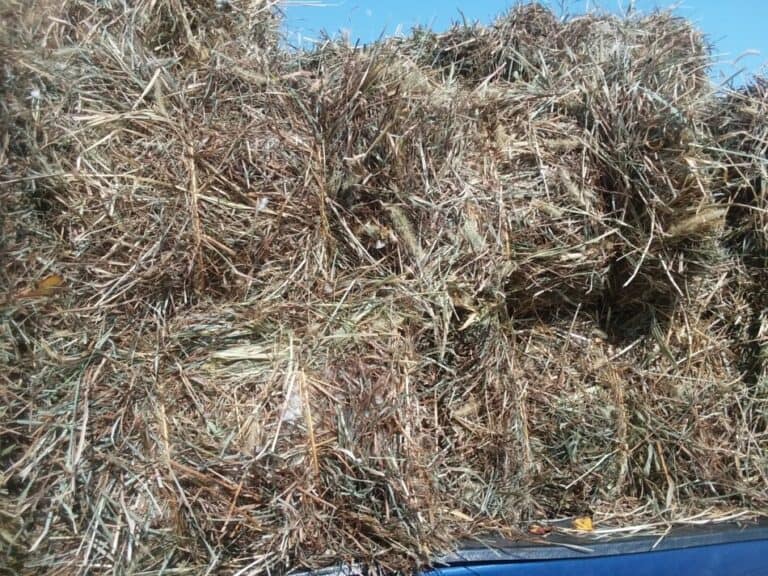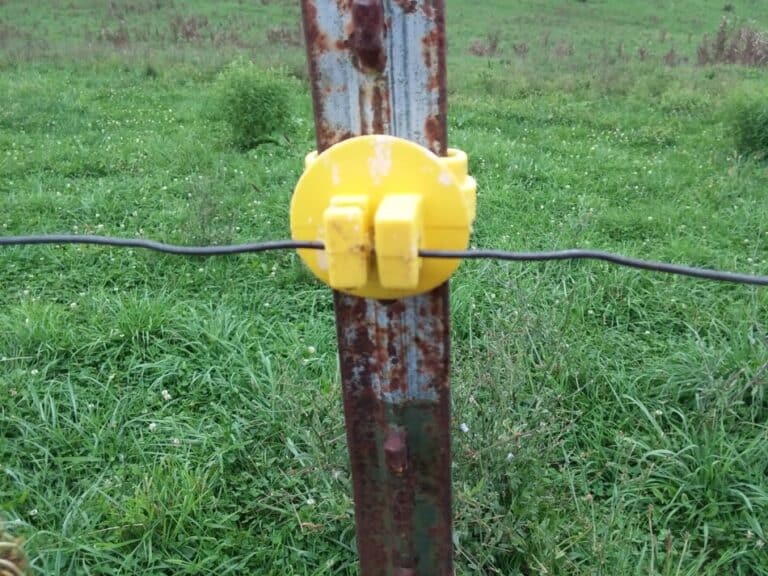Oatlage: What It Is And Why We Grow And Feed It!

If you’ve never tried using oatlage to feed your sheep or cattle, you are missing out!
They love it and it’s pretty easy to make. Plus, in a wet year it is easier to get harvested than dry hay.
Oatlage is a fermented hay that is made from the oat plant, not the grain. The oats are cut as a forage crop, baled wet and wrapped in plastic.
We decided to grow our own oatlage for two reasons:
- the summers have been challenging regarding getting dry hay made
- we reseeded the previous year’s corn fields to hay using an oat nurse crop, so we’ve got the oats growing each spring.
Oats do a super job for us as a nurse crop and grow well in our area of Ohio. However, they tend to take extra time to dry down for hay.
The past few years, we have not had that extra time!
Making Haylage: 6 Common Mistakes goes over the simple but important things that are easy to mess up with haylage. Good news, they are also easy to prevent!
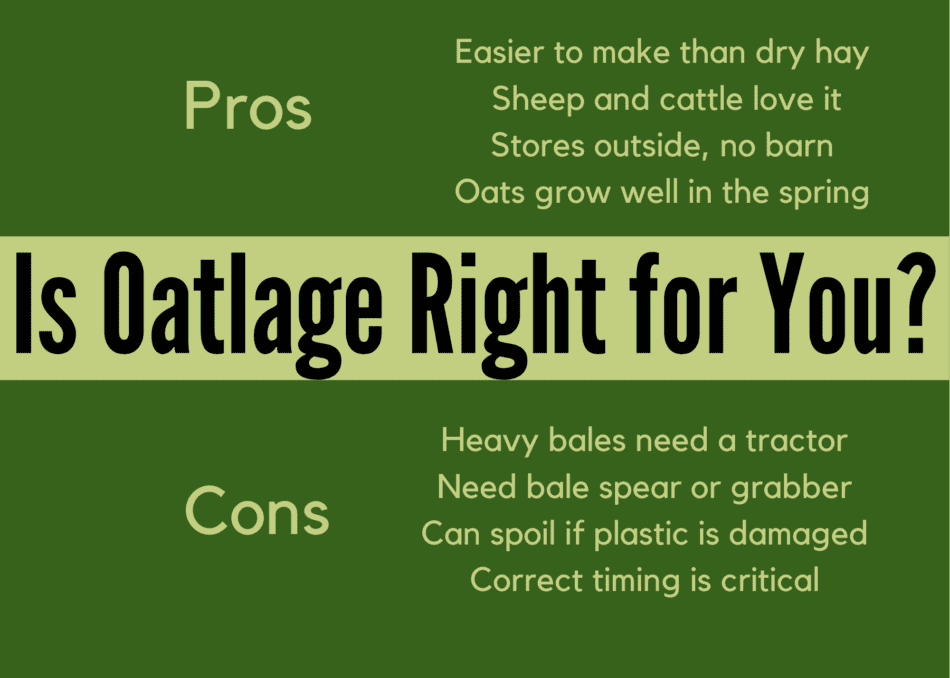
Since we have the oats, could always use more feed, and need to reliably harvest that feed we decided to make the oats for oatlage.
We wrapped all of the oatlage as individual bales.
The other wrapping option was to put them into a tube like we did for another field, the clover seeding, that we wrapped earlier in the year.
We thought the single bales would be more convenient to use.
Especially since, once you open the tube the air can spoil bales if you don’t use them quickly enough.
Haylage shows you what haylage is and why you might consider using it.
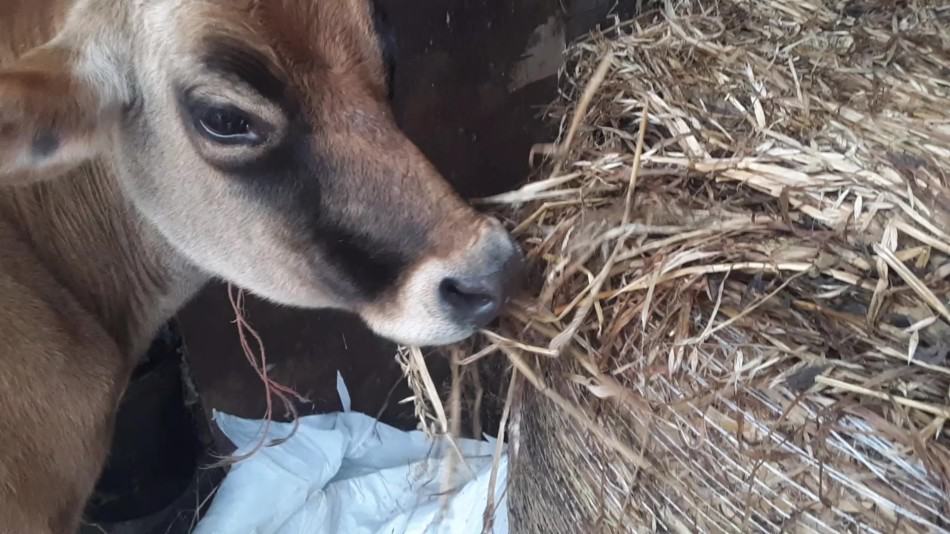
What is oatlage?
Oatlage is moist, fermented hay made from the oat plant. The oatlage must be cut off from air by plastic or being stored in a silo, since it is moist hay.
Dry hay will store for months, moist hay will rot if allowed to sit exposed to the air. But, restrict the air from that moist hay and the hay will ferment, instead of rotting.
The idea of fermenting oatlage is similar to shredded cabbage being packed into a jar then fermenting into sauerkraut.
The reason the cabbage ferments (instead of spoiling), is the air restriction, just like the oatlage.
The oats that are commonly grown for the grain (in our area that is Jerry Oats), can be used for oatlage.
However, if the planned harvesting of the oats is for forage, most farmers would plant a forage variety of oats.
We planted the majority of the field to forage oats, since we knew we didn’t want the grain and a forage oat will yield more bales per acre.
Forage oat varieties grow more leafy, producing more top growth, before they reach maturity. Since the oatlage is cut just before the plant is mature, the forage type oats produce more forage per acre than the varieties grown for grain.
Here’s a wonderful PDF on Forage Oats from King’s AgriSeeds, going over the differences between forage and grain oats and using oats as a nurse crop.
Why make oatlage?
We make oatlage, instead of oat hay, simply because it is more likely to be successfully harvested than dry hay and our animals like it and grow well eating it.
We’ve been having wet summers for the past few years, great for grass growth, not so great for making hay.
We need to get the oats off of the new hay seeding quickly and for us, oatlage is the best way to do it.
Trying to harvest the oats as dry hay would take an extra day or two at best. Lately, that many days of sun in a row hasn’t been likely.
Oats are fast growing in the cooler, wet weather of spring. This makes oats ideal for use as a nurse crop for a new hay seeding.
The oats pop up and take off growing quickly, covering the soil to keep in moisture and protect the slower to establish seedlings.
Oatlage stores outside, no barn space needed
Another reason for harvesting the oats as oatlage is that the bales do not need to be stored under roof.
The plastic keeps the oatlage safe from weather damage. Not needing a barn is a huge plus for us, we don’t have much easy in, easy out barn space for storing hay.
We put our bales along the side of a driveway where they are easy to access in nearly any weather with the tractor.
Where ever you choose to put the bales must be out of the way, so the plastic is safe from damage and they don’t need to be moved later.
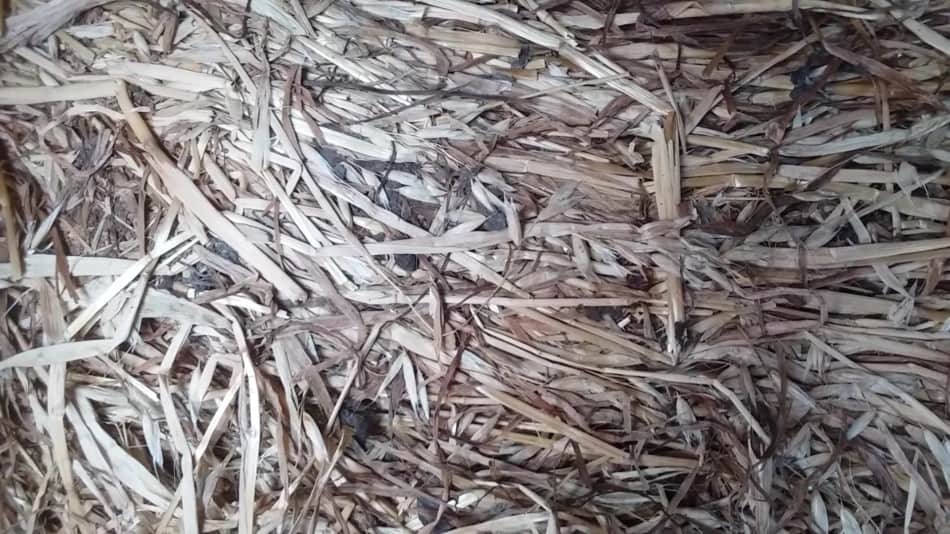
How is oatlage made?
The oats are planted in the spring as early as we can, generally we are shooting for March, at the earliest.
The oats can handle some cold weather, but will winter kill if they are in a really cold snap.
The fact that the oats will winter kill is why we can’t plant them in the fall of the previous year, like wheat or rye.
In most years, fall planting of small grains would be easier to do than spring planting. With oats that won’t work, they are spring only.
Once the field is planted, nothing else needs to be done except making sure the livestock are kept off of it.
Now we wait and occasionally monitor the growth to know when to plan harvesting.
The oats are cut right as the seed heads start to emerge out of the growing point of the plant.
The cut oats are left in the field a few hours to overnight, depending upon your area. Then the field is harvested at a higher moisture than that of dry hay.
Harvesting the oatlage
There are two options for harvesting, baling or chopping. We baled ours in round bales. We could have had our oatlage bagged, but we chose to bale it instead.
Chopping the forage would be an option for anyone with a silo (bunk or upright) or a bag.
The biggest up side to chopping is the livestock will do less sorting of the forage, since the pieces are all the same size.
With the bales, the our sheep can sort out the bigger pieces and drag them out of the feeder. Chopped and put in a bunk feeder, they would eat it all.
The oats are cut the day before they are baled. This amount of time is based on letting the oats dry down a little, but not too far.
What we are looking for is more like wilting the oats than drying them.
This is where the process will vary for you. The oats are baled at 60% moisture.
For your area, this moisture level can come sooner or later than the day after cutting.
You’ll just have to monitor it and see how the oats are drying down that particular day.
Wrap the bales immediately
Once the oats are baled they need wrapped immediately, especially for individually wrapped bales.
If the bales sit in the field, they get a flat spot and will not roll around on the wrapper evenly.
Uneven bales seem to take forever to wrap. Get to wrapping right away.
Cost to wrap oatlage
| What we paid for | Cost |
| Individually wrapped bales | |
| Roll of plastic to wrap oatlage | $70 per roll |
| Rent on the wrapper (we operated the wrapper) | $5/bale wrapped |
| Tube wrapped bales | |
| Put bales in tube (wrap and tuber he operated) | $7/bale tube wrapped |
The cost to wrap the bales was $70 for the plastic, which did about 20 bales and $5.00 per bale rent on the wrapper.
A neighbor who lives a few miles away has the wrapper that we rent.
We also wrapped some clover hay this year and put it into a tube instead.
We paid a neighbor to come and put in the tube for us, which cost $7 per bale, plastic included.
Need to be fast? Wrap in the tube
On a side note, if you are looking for speed in completing the process of wrapping your oatlage, the tube wrap is the way to go.
It is super fast to tube wrap bales compared to individually wrap them.
You’ll need to know where you are getting the wrapper from before you cut the oats. Timing is the key to successful oatlage.
Making Baleage is a University of Wisconsin paper getting more specific into making good baleage.
Is oatlage suitable for sheep?
Yes, winter feed for the sheep is the main reason we made the oatlage. Sheep love it and seem to grow well on it.
The cattle like it as well, as you can see in the first picture!
We just have more sheep to feed than cattle, so the sheep were the main consideration when making the oatlage.
Right now we are feeding out some of the ram lambs in the barn and their main diet is oatlage. They do pick through it a little, I’d guess less than 10% is leftover.
Since we are trying to to put weight on this group of ram lambs, we do not push them to eat all of the hay.
If the oatlage was feeding sheep on more of a maintenance diet, they could be given more time to eat what is left in the feeder.
This would take the picked over percentage down to nearly nothing.
We take the longer, picked over pieces they leave and give it to the group of ewes beside them.
This leftover oatlage is all the supplemental forage these ewes are getting to eat and they are doing well on it.
Considerations when using oatlage
Having the oats stored as oatlage is not all roses. There are a few things that may trip you up, if you are not ready for them.
- You need a tractor to move the bales
- You will need a spear or a grabber attachment for the tractor
- Ripped plastic equals spoiled bales
- Custom baling and wrapping can have timing problems
- Feed bale within 3 days, 5 if cool
You’ll need a tractor
The main drawback for the small farmer considering oatlage, or any other haylage, is the need to move the bales with a tractor.
The tractor needs to be big enough to handle the weight of the bale on the 3 point hitch or on the loader, whichever you are using.
These bales are heavy. You will not be able to move them around by hand.
We push dry round bales around all of the time, in some places it is just easier than getting the tractor. These bales are a different story, get the tractor.
You need a way to grab the bales
Moving the bales can be done with a spear, a bale grabber or a bale unroller. Which one you choose doesn’t matter, but you will need something.
We feed oatlage and haylage on the field to the ewes, using a bale unroller.
This is handy. The unroller grabs the bale from the flat side and rolls the hay along the ground.
We just roll out the amount of haylage we want the sheep to have and then pick up the remainder of the bale and drive on out.
The unroller can also be used to grab a bale and put it in the barn.
Please note, the unroller will puncture the plastic on the bales, so don’t move any bale you need to keep wrapped, only move bales you will be using right away.
Ripped plastic = spoilage
Punctures in the plastic are more of a concern in the heat and earlier in the fermentation process.
A hole in the plastic is never a good thing, it’s just less of a concern if the bale has already fermented and when the weather is cooler.
A small hole will make a smaller rotten spot in the bale, but the spot will still be much bigger than the hole.
The comparison I have run across is that a quarter sized hole results in a basketball size bad spot. Not the end of the world, but not great either.
The best way to keep the spoilage to a minimum is to check the plastic on the bales every few days.
This way you’ll catch a tear early and be able to tape it before the bale starts to spoil.
There is tape you can buy to patch the holes. I used duct tape, like you are told not to, and it worked for a few weeks but that’s it.
If you need the tape to hold, buy the tape specifically made to patch agricultural plastic that sits out in the weather.
Custom work can have timing problems
Our first round of haylage, not the oatlage, we had some problems getting it made on time.
We hired a custom guy to come and bale then wrap it. He baled it and as he was leaving said he couldn’t wrap it, yikes!
Once the haylage is in the bale it must be wrapped on time or it will not ferment, it will spoil!
Luckily, we were able to get the farmers with the tube wrapper to come and save us.
They showed up a 9:30 at night, (we had only gotten a hold of them a few hours earlier and they had to finish things at home first). What great guys to come help us out on such short notice!
So, this did turn out fine for us, but it was a very frustrating and stress filled few hours there until we got a call through to someone able to help.
Once open, feed bale in 3 days
The final consideration, especially for a small farmer, is the bale should only be open for 3 days.
We find up to 5 days or so in cold weather will work, but less time open until it is fed is better.
If you just have a few sheep or a few head of cattle. it will be tough for you to use all of the oatlage while it is at it’s best nutritionally.
